The first of Baldwin’s (www.baldwin.co.uk) two official Coinex auctions will be held on the 28th September this year and will include a spectacular selection of Ancient and British Coins, Military and Commemorative Medals and South African Banknotes, Coins and Medals.
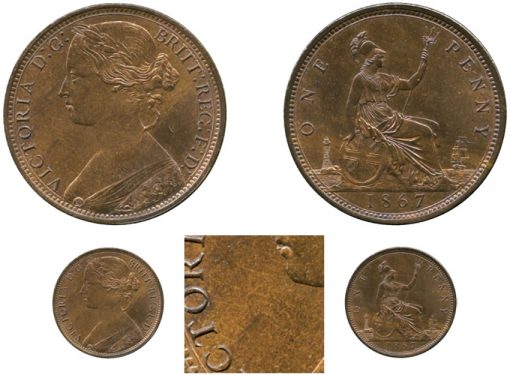
Numerous lots in the sale carry some fascinating historical references and are sure to attract a great deal of interest from collectors. Taking place at the CIPFA Conference Centre the auction will be well attended as buyers fly in from around the globe for the Coinex fair arranged by the BNTA.
Auction 70 (http://www.baldwin.co.uk/auction-70) begins with a beautiful array of Ancient Greek, Roman and Byzantine coins. Lot 7, a Thrace, Maroneia (c.386-348 BC), Silver Stater, a very fine piece has an exceptional pedigree dating back to the sale of the Bompois Collection by Hoffman in 1882, this piece carries an estimate of £3,500-4,500.
Lot 20, an Ionia Electrum Stater (c.650-600 BC) is an important and extremely rare stater as it is an example of the first true coin, bearing an obverse type as well as a reverse punch. Prior to this, small ingots with blank surfaces had been produced, followed by the addition of a reverse punch and eventually the striated obverse. On the basis of hoard evidence, it is likely that these issues were struck at Ephesos and possibly Sardes. This lot is estimated at £6000-8000.
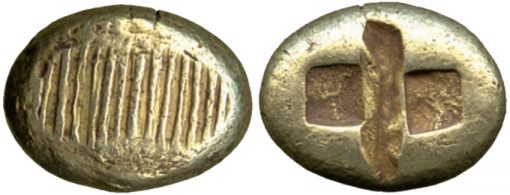
From the Byzantine section lot 72 is the most notable example, a well struck and extremely rare Annastasius II Srtemius (AD 713-715) Gold Solidus with an excellent portrait, estimate £5,000-6,000.
British coins are, as usual, well represented in the sale and include an interesting collection of English copper and bronze, the property of an English gentleman. The highlight of this section being lot 122 (shown in top image), an 1867 Victoria, Bronze Penny, with experimental numbers 570 / 357 hand scratached in to the obverse field by face. This piece is unique, having been selected for the Pyx trial (a procedure used in the UK to ensure newly minted coins adhere to the required standards) and the numbering indicative of use at the trial. This particular numbered striking was predicted to exist in Gouby’s "The British Bronze Coinage Pence Halfpence and Farthings 1860 to 1869".
Lots 349-365 consist of a small group of Anglo-Saxon coins, a number of which are from the West Country Mints and are quite rare.
Lot 361, a Harthacanute (1035-1042) Penny, jewel cross type, Northman of Lewes, is the most notable amongst them.
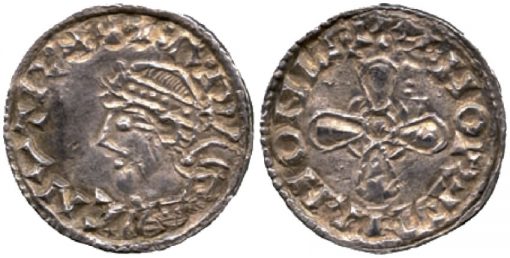
This distinctive piece is unusual as the reverse of the coin is die-linked and shared with the obverse of Harold I. Most mints of the period were either producing coins with the head of Harold I or the head of Harthacanute, to show their allegiance to either the British or the Danish half brothers who were jointly ruling at the time. The Moneyer Northman of Lewes mint however, produced coins with obverses of both kings but used the same reverse die. The piece is estimated at £3,000-4,000.
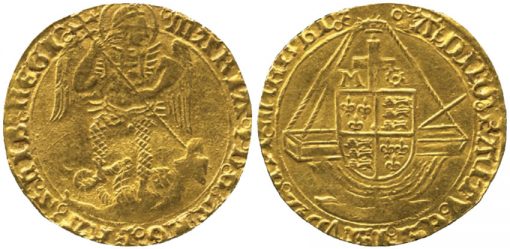
Other highlights of the section include lot 366, an Edward III (1327-1377) Gold Noble, fourth coinage estimated at £7,000-9,000 as it is extremely rare to find in such excellent condition; Lots 368-377 a run of hammered gold Angels from Henry VI — Charles , estimates range from £1,200-6,000 and lot 382, an impressive and rare representation of 21 Silver Maundy Sets in a glass frame, estimate £6,000-7,000.
The Coinex auction 70 continues with a superb selection of South African banknotes including lots 405-428, a selection of Mafeking paper currency issued by authority of Col. R.S.S. Baden-Powell, Commanding Rhodesian Frontier Forces.
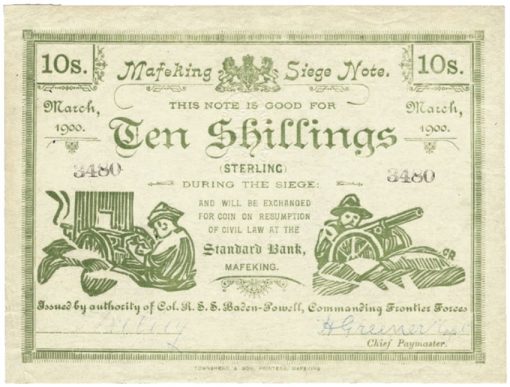
Robert Baden-Powell is most famously known for his involvement in the formation of Scout Troops throughout the British Empire and other countries, through his book ‘Scouting for Boys,’ published in 1908.
Baden-Powell served in the British army from 1876-1910 in India and Africa, joining as a young Officer specialising in scouting, map-making and reconnaissance. In 1899, during the second Boer War, he was involved with the Siege of Mafeking. The most famous British action of the war, Commander Robert Baden-Powell is credited with masterminding much of the defence of the garrison.
The Mafeking Mail on 25th January 1900 carried an announcement that paper currency for Threepence, Sixpence, Ninepence, 1-Shilling, 2-Shillings and 3-Shillings was to be issued in an attempt to overcome the scarcity of coinage. The smaller values never appeared but notes for 1-Shilling, 2-Shillings and 3-Shillings were issued. They carry an embossed revenue stamp of Bechuanaland Protectorate with the facsimile signature of Captain H Greener (Paymaster General). The facsimile signature of Mr R Urry (Manager of the Standard Bank) was added to the next denomination for 10-Shillings and when £1 notes were finally printed it was decided that they should be handsigned by Mr Urry and Captain Greener. Estimates for these lots range from £80-1,500.
Lots 501 and 593 from the Commemorative Medal section of the sale comprise, a Captain Cook 1779 Royal Society Medal by L Pingo and a 1779 Death of Captain Cook Bronze Medal and are of particular interest, both in fantastic condition and rare. The first of the two was commissioned by The Royal Society in gold, silver and bronze to commemorate the death of Captain James Cook when he did not return from his final voyage in 1779. The society had planned his three voyages and Cook was made a fellow of The Royal Society in 1775 on return from his second expedition.
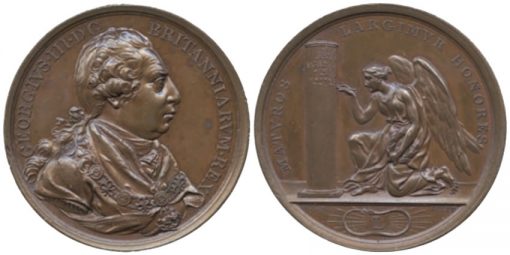
Lewis Pingo was a member of the Free Society of Artists. In 1776 he succeeded his father as assistant engraver at the mint quickly becoming chief engraver in 1779 where he remained until his retirement in 1815. Whilst working at the mint Pingo engraved the dies for the shillings and sixpences of George III in the issue of 1787 and the second variety of the Maundy money of George III. He was also responsible for engraving the dies for the three-shilling Bank token and for the East India Company’s copper coinage and the patterns for the guinea, seven-shilling piece, penny and halfpenny of George III.
In addition to the Cook medal mentioned here Pingo is well know for, amongst others, the 1773 medal of Dr. Richard Mead and the 1780 Freemasons’ Hall medal, ‘Defence of Gibraltar. His medals are signed L. P. and L. PINGO.
Cook’s third voyage, to search for the a north-west passage from the Pacific to the Atlantic, was to be his final. During the voyage Cook discovered the Hawaiian islands where he was murdered by natives in 1779. Little is know about the second of the medals to be included in this sale, the obverse depicts the bust of Cook in naval uniform and the words ‘CAPT: JAMES COOK,’ the obverse is inscribed with the words ‘Courage and Perseverance / Born 1728 Died 1779.’ The item is extremely scarce and was struck soon after the news of Cook’s death reached England, it carries an estimate of £4,000-5,000.
A small but perfectly formed selection of Orders, Decorations and Medals completes the first day of this exceptional sale. Lot 897, a fine and early George Medal, was awarded to Volunteer Frederick Dainty Cox a Telegraph Lineman’s Assistant with the Great Western Railway, and member of the Forest of Dean Home Guard, awarded for bravery in clearing two unexploded German time bombs immediately following an air raid, comprising: George Medal, George VI (Frederick Dainty Cox), engraved in upright capitals, mounted with pin for wear, in original box of issue. The lot is estimated to achieve £2,500-3,000.
Lot 907, the rare and interesting Naval General Service Martinique and Arctic Exploration Pair was awarded to Boatswain Robert Silvers.
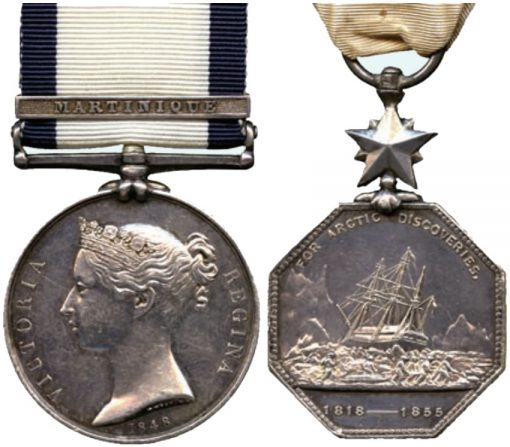
A Scotsman captured aboard the American vessel Elizabeth in 1806, he then impressed to serve aboard HMS Cleopatra, being present at the capture of Martinique; reaching the rank of Boatswain and serving the Royal Navy for nearly 30 years. He was personally requested by Commander D C Clavering to serve as Boatswain aboard HMS Griper during the expedition to East Greenland in 1823. The lot comprises: Naval General Service Medal, 1793-1840, single clasp, Martinique (Robert Silvers.); Arctic Medal, 1857 (Robert Silvers 1823), suspension once repaired; the first officially impressed, the latter correctly engraved in italic capitals, and is estimated to sell for £4,000-5,000.
For more information visit www.baldwin.co.uk/auction-70.
For all enquires about this or any future auctions please contact Seth Freeman atseth@baldwin.co.uk or on +44 (0)20 7930 9808.
ADDITIONAL BALDWIN’S COINEX AUCTION 70 HIGHLIGHT DETAILS
7 ANCIENT COINS. Ancient Greek. Thrace, Maroneia (c.386-348 BC), Silver Stater, bridled horse left, loose rein trailing, rev ΕΠΙ ΑΠΕ ΛΛ ΛΩ around linear square, within which vine with four branches of grapes, 10.52g (Schönert-Geiss 427.1 (V 10 / R 16); West 140, 102h). Dark patina, very fine and with a wonderful old pedigree. ex Bompois collection, Hoffman, 16 January 1882, lot 592 ex Weber collection, pl. 90, 2334 ex Naville IV, 17 June 1922, lot 482 ex Niggeler collection, Leu & MMAG, 3 December 1965, lot 197
Estimate: £3500-4500
20 ANCIENT COINS. Ancient Greek. Ionia, Uncertain (c.650-600 BC), Electrum Stater, Milesian standard, striated surface of scored lines, rev irregular vertical punchmark between two square punchmarks 14.28g (BMC 1, pl.III, 3 = Traité pl.I, 12). Extremely fine for type, very rare. This important and extremely rare Stater is an example of the first true coin, bearing an obverse type as well as a reverse punch. Prior to this, small nuggets with blank surfaces had been produced, followed by the addition of a reverse punch and eventually the striated obverse. On the basis of hoard evidence, it is likely that these issues were struck at Ephesos and possibly Sardes.
Estimate: £6000-8000
72 ANCIENT COINS. Byzantine. Mint of Constantinople, unless otherwise stated. Anastasius II Artemius (AD 713-715), Gold Solidus, dN ARTEMIUS A-NASTASIUS MUL, crowned bust of emperor facing holding globus crugiger and akakia, rev VICTORIA AVGU Z, cross potent on three steps, CONOB in exergue, 4.37g (MIB 2; S 1463). Faint scratch on the reverse, otherwise well-struck with an excellent portrait, extremely fine and very rare.
Estimate: £5000-6000
122 BRITISH COINS. Victoria, Bronze Penny, 1867, young laureate bust left, experimental numbers 570 / 357 hand scratched into the obverse field by face, legend VICTORIA D:G: BRITT:REG:F:D surrounding, rev Britannia helmeted seated right on rocks, with trident and shield, bell topped lighthouse to left and ship to right on sea, date in exergue, legend ONE PENNY within linear circle which sea crosses (cf Peck 1678; cf Fr.53 dies 6+G; Gouby table 9a; cf S 3954).
Toned, uncirculated and unique, the piece having been selected for Pyx trial and the numbering indicative of the use at trial. Offered for the first time for sale since Gouby’s insightful research into the numbered strikings published in "The British Bronze Coinage Pence Halfpence and Farthings 1860 to 1869"; published and updated since 2005.
This particular numbered striking predicted to exist in table 9a on page 34 and not listed in the "known" table 1 on page 7 (no doubt to be edited by Mr Gouby in future editions). This coin was purchased from Canadian dealer Randy Weir at the Long Beach Coin Convention in June 1986. It was previously seen by Graham Dyer, then Curator of the Royal Mint Museum.
Estimate: £2000-2500
361 ANGLO-SAXON COINS. Harthacanute (1035-1042), Penny, jewel cross type (Spring to Autumn 1036), Northman of Lewes mint, diademed bust left, +H:A.R CNVT R, rev cross of four lobes united by twin circles and central pellet, +NORÐMAN ON LÆP, 1.09g (SCBI 40:82; N 808; S 1166). Toned, a little double-struck on the reverse, good very fine and rare. The reverse die of this coin is die-linked and shared with an obverse of Harold I. The Moneyer Northman was striking coins with obverses of each King under the joint rule at Lewes in Sussex which was the portion of the Kingdom devoted to Harthacanute. See SCBI 40:255 for the Harold I with the same unusual and distinctive reverse die.
Estimate: £3000-4000
366 BRITISH COINS. Edward III (1327-1377), Gold Noble, fourth coinage, Treaty Period, king standing in ship holding sword and shield, four whole lis in upper left quarter, ship rigging with three ropes to left and two to right, ornaments on top line of hull -11-11 quatrefoils 4/4, lower part of bowsprit absent, annulet before king’s name, saltire stops both sides, rev large closed E at centre, ornate cross with bifoliate crown over lion in each angle, all within tressure of eight arcs, large fleurs in spandrels, initial mark cross pattée, 7.73g (cf Schneider 87/86; cf Doubleday -/223; N 1232; S 1503). Struck on a broad fully round flan, very well defined with a superb portrait and light red tone, a pleasing extremely fine and very rare this fine. with Spink or Seaby ticket dating from 1949, priced at £20.
Estimate: £7000-9000
382 BRITISH COINS. Maundy Sets (21 Sets), housed in custom made A H Baldwin & Sons Ltd wood and glass presentation frame with hinged lid and blue velvet pad, wooden hinged strut on rear to display frame upright; contains: Charles II (2), first milled issue, about very fine, 1681, very fine, James II, 1687, toned good very fine, William and Mary, 1689, twopence good fine, others nearly extremely fine, William III, 1701, good fine to very fine, Anne, 1713, toned good fine, George I, 1723, about very fine or better, George II, 1735, good very fine to extremely fine, George III (4), 1786, first issue, toned extremely fine, 1792 wire type, bright about extremely fine 1800, cuirassed bust, toned practically as struck, 1820, last type, toned practically as struck, George IV, 1830, toned extremely fine or better, William IV, 1831, toned practically as struck, Victoria (3), 1878, young head, toned good extremely fine, 1891, Jubilee type, good extremely fine, 1898, old head, toned good extremely fine, Edward VII, 1902, bright good extremely fine, George V, 1936, practically as struck, George VI, 1950, good extremely fine, Elizabeth II, 1953, toned as struck. (84) A very rare type assemblage of sets, containing the rarest years of 1689 and 1953, an unusual opportunity to own such a group.
Estimate: £6000-7000
501 COMMEMORATIVE MEDALS. British Historical Medals. Captain Cook, The Royal Society’s Bronze Memorial Medal, 1779, by L Pingo, bust left, rev NIL INTENTAVM NOSTRI LIQVERE, Fortune standing against rostral column with rudder on globe, 43mm (Betts 553; BHM 258; Eimer 780). Extremely fine, the obverse particularly good, scarce.
Estimate: £300-500
593 WORLD MEDALS. Australia. Death of Captain Cook, Bronze Medal, 1779, unsigned, CAPT. JAMES COOK, uniformed three-quarters bust right, rev COURAGE AND PERSEVERENCE, in exergue BORN 1728 DIED 1779, edge plain, 37mm (Betts 555; BHM 218, R2; Eimer 778; MH 1919, 375). Light cabinet wear to the higher points, good very fine and very rare.
Estimate: £4000-5000
897 ORDERS, DECORATIONS AND MEDALS. ORDERS. GALLANTRY GROUPS & SINGLES. A fine and early George Medal awarded to Volunteer Frederick D. Cox, a Telegraph Lineman’s Assistant with the Great Western Railway, and member of the Forest of Dean Home Guard, awarded for bravery in clearing two unexploded German time bombs immediately following an air raid, comprising: George Medal, George VI (Frederick Dainty Cox), engraved in upright capitals, mounted with pin for wear, in original box of issue. Lightly toned, polished with some associated hairlines, otherwise good very fine and scarce.
LG, 28 March 1941 Frederick Dainty Cox, originally of Birmingham, had been living in Lydney, Gloucestershire, with his wife and three children for six years before earning his George Medal for bravery during The Blitz, immediately following an air raid near the Woolaston & Beachley Junction, on the 9th of November, 1940.
he London Gazette citation reads: "Immediately after an enemy air raid, it was found that railway communications had been broken. Cox and another railway-man were sent to examine the line and discovered that one bomb had exploded and broken several telegraph wires, while an unexploded time bomb had fallen on the permanent way.
After repairing the most important of the damaged telegraph circuits, Cox carried the bomb to the down side of the line and dropped it over the boundary hedge on to the soft ground. This enabled a single line to be put into operation.
Although warned by the police to stop work, as another time bomb had been dropped nearby, both men continued until repairs to the wires had been completed. Cox then searched for and found the second bomb and helped the Bomb Disposal staff to move it to a place of safety."
When interviewed by the Three Forests newspaper concerning his Investiture at Buckingham Palace, the report notes Mr Cox as saying:
"The King, after performing the ceremony, shook my hand and asked me how long I had been in the Home Guard. I expected it would be a terrible ordeal, but there was a delightful lack of formality and I enjoyed it very much."
Another newspaper cutting shows that when once again asked about the matter, that Volunteer Cox remarked, with a smile:
"Quite enough has been said already. I simply did my duty."
In a handwritten letter to Volunteer Cox from his CO of the Gloucestershire Home Guard, the Commanding Officer writes:
"Having seen something of men & the actions they take when they conceive it to be their duty, I long ago came to the conclusion that a right-thinking and modest Englishman with the necessary ‘guts’ would do what you so gallantly did, in carrying out what you conceived to be your duty. That you are a member of the Home… fills me with pride, because it brings honour and credit to us."
Sold with a folder of research and information, containing a quantity of newspapers cuttings, 3 photographs, telegrams and letters of congratulation from the Great Western Railway, The Ministry of Transport, and the Commanding Officer of the Gloucestershire Home Guard; as well as an invitation to attend the investiture at Buckingham Palace, and several cards and letters from the Royal Society of St George.
Estimate: £2500-3000
907 ORDERS, DECORATIONS AND MEDALS. ORDERS. CAMPAIGN GROUPS. The rare and interesting Naval General Service Martinique and Arctic Exploration Pair awarded to Boatswain Robert Silvers, a Scotsman captured aboard the American vessel Elizabeth in 1806, he then impressed to serve aboard HMS Cleopatra, bring present at the capture of Martinique; reaching the rank of Boatswain and serving the Royal Navy for nearly 30 years, Silvers was personally requested by Commander D C Clavering in to serve as Boatswain aboard HMS Griper during the expedition to East Greenland in 1823, comprising:
- Naval General Service Medal, 1793-1840, single clasp, Martinique (Robert Silvers.);
- Arctic Medal, 1857 (Robert Silvers 1823), suspension once repaired; the first officially impressed, the latter correctly engraved in italic capitals, pair loose. Pair toned, pleasing very fine, lightly polished with a few light contact marks, rare and with scope for further research. (2) NGS ex J B Hayward, June 1971, lot 2 Arctic ex Spink, Numismatic Circular, March 1973, item 2867 Robert Silvers was born in Stirling, Scotland, c.1783.
Having presumably emigrated to Boston to take up work, he was discovered to be part of the crew of the American vessel ‘Elizabeth’ of Boston, during an inspection by HMS Tartar in 1806, having been amongst the ‘three men who had secreted themselves away… (and) were found below’. The Elizabeth was subsequently taken in tow to Bermuda, and despite his claims at the time to be a native of Boston, Robert Silvers was pressed into service with the Royal Navy.
Inspections of this type were typical during this period, as the Royal Navy sought to reclaim British deserters to provide manpower for the vast British Fleet. This action was perceived as a slight upon American Sovereignty, which considered British deserters to have the right to become free American citizens. Similar blockade and inspection incidents such as the Leander Affair and the Chesapeake-Leopard Affair, would directly contribute to the tensions which led to the War of 1812.
Having spent nine months aboard HMS Tartar, during which time he proved his worth and took the rank of Able Seaman, Robert Silvers was soon transferred to HMS Cleopatra on 22 September 1806.
During the next four years he would steadily receive recognition for his services, retaining the rank of Boatswain’s Mate on 27 September 1810. Whilst aboard the HMS Cleopatra he took part in the capture of the French island of Martinique in February 1809.
Robert Silvers was discharged on 19 August 1811 to HMS Africaine. Perhaps having decided to tell the honest truth regarding his place of birth, whilst coming aboard HMS Africaine he gave his age as 28 years old, with his true birthplace now listed as Stirling. He also at this time began making allotment payments (18/8d per month) to his mother Janet Silvers at Stirling.
He would serve aboard HMS Africaine until 17 March 1815, when he was discharged to HMS Leda on promotion to Acting Boatswain, serving with her for a little over a year, when he transferred to HMS Tyne with the full rank of Boatswain — the rank he would hold until the end of his career.
As a Boatswain, he would see service aboard a further ten vessels (see service records), which would include a voyage to Spitsbergen and East Greenland in 1823 aboard HMS Griper. Commander D C Clavering, who was tasked with leading this voyage, specifically requested Robert Silvers for the position of Boatswain, whom he considered ‘a steady, active and desirable man’ (Commander D C Clavering’s Voyage to East Greenland, 1823, by A G E Jones; Musk-Ox, 19, p.16, 1976), although the link between the two is not yet known to the cataloguer.
On this voyage, Captain Edward Sabine was taken to the Arctic North to continue his scientific investigations into the shape of the earth at the request of the Board of Longitude. In addition to this, Clavering’s voyage was intended as a cartographic exploration of the area of East Greenland, and to venture as far north into the pack ice as they could manage. Whilst Sabine’s experiments at Pendulum Island were considered a success, Clavering and the crew of Griper also had a rare encounter with the local Inuit tribes — a meeting which proved the first and last meeting of Europeans and the indigenous islanders, who soon after went extinct.
Robert Silvers was eventually discharged from the Royal Navy in late September 1835, at the culmination of career of nearly 30 years. Genealogical research shows him as living in Portsea Town, 1841, residing with his wife Amelia and two children, Rachael and George, his career noted as ‘Mariner’. He is later listed as living alone, at the age of 75 in 1861. On both occasions, his birthplace is listed as Scotland.
Sold with copy service papers 1815-1835, census information, medal roll mentions, and several copy log book entries concerning HMS Tartar and the American vessel ‘Elizabeth’, and a quantity of further information, confirming both awards to the same man.
Estimate: £4000-5000
About Baldwin’s
Established in 1872 A. H. Baldwin & Sons Ltd (www.baldwin.co.uk) has over 100 years experience in servicing the numismatic industry. Although founded much earlier, the name A.H. Baldwin & Sons didn’t become synonymous with the London numismatic scene until 1901 when Albert Henry set up his first London based premises on Duncannon Street with his eldest son Percy, joined later by his two other sons Fred (legendary cataloguer of King Farouk of Egypt’s coin collection) and Roy.
Baldwin’s auction department was established in 1993 and has grown to hold between ten and twelve sales annually in London, New York, Hong Kong and Dubai and specialize in all areas of Numismatics.





